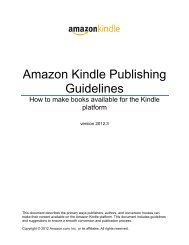Amazon Guidelines
Guidelines for self created
Guidelines for self created
Create successful ePaper yourself
Turn your PDF publications into a flip-book with our unique Google optimized e-Paper software.
Publishing on Kindle: <strong>Guidelines</strong> for Publishers<br />
Features & Benefits Supported<br />
on Kindle<br />
e Inkbased<br />
Device<br />
Full support for CSS to enable publishers to<br />
control all elements of the text layout, including<br />
line spacing, alignment, justification, margin,<br />
color, style, & border.<br />
Support for drop cap character at the beginning<br />
of paragraphs.<br />
Supported on<br />
Kindle<br />
Applications for<br />
PC, Mac,<br />
Android,<br />
Windows Phone<br />
No No Yes<br />
No No Yes<br />
Support for floating elements that includes<br />
boxed text, callouts, sidebars, & images with<br />
text wrapping.<br />
No No Yes<br />
Support for numbered and bulleted lists. No No Yes<br />
Support for nested tables and merged cells<br />
required by technical and textbooks.<br />
No No Yes<br />
Support for background images on pages and<br />
for text on background images.<br />
No No Yes<br />
Support for Scalable Vector Graphics (SVG) No No Yes<br />
that can be zoomed without loss of fidelity.<br />
Support for embedded fonts that allows<br />
publishers to have a custom look & feel for the<br />
book.<br />
No No Yes<br />
Support for rounded corners of boxed elements. No No Yes<br />
Support for drop shadow. No No Yes<br />
Support for outline text. No No Yes<br />
Support for multiple and repeated background<br />
images.<br />
No No Yes<br />
Support for color gradient. No No Yes<br />
Enables fine-grained control of attributes for text<br />
and other elements through CSS selectors.<br />
No No Yes<br />
Support for fixed-layout pages for specified No No Yes<br />
screen sizes.<br />
Supported on<br />
Kindle Fire<br />
Tablet<br />
There are important differences between writing HTML for websites and for Kindle books. To provide a<br />
good reading experience, many website design practices should be avoided when creating Kindle books.<br />
Refer to the following sections for more information.<br />
Support for Chinese, Japanese, and Korean Text<br />
The Kindle family of devices has limited support for Chinese, Japanese, and Korean text. The Kindle<br />
Readers for e Ink devices and applications can render horizontal left to right Chinese, Japanese, and<br />
Korean text. They have limited font support for the CJK characters. There is no support for right to left<br />
vertical scripts and no support for Japanese Ruby script.<br />
3.1 Text <strong>Guidelines</strong><br />
3.1.1 Text Guideline #1: Normal Text Must Use Defaults<br />
The normal text in a Kindle book must be all defaults. <strong>Amazon</strong> encourages content creators to use<br />
creative styles for headings, special paragraphs, footnotes, tables of contents, etc., but not for normal<br />
text. The reason for this is that any styling on normal text in the HTML would override the user’s preferred<br />
default reading settings. Users report such behavior as a poor reading experience. Here are the most<br />
important points:<br />
• Normal text must not have a forced alignment (such as left aligned or justified).<br />
• Normal text must use the default font size. Normal text should not use the <br />
tag or its equivalent in CSS.<br />
Kindle Publishing <strong>Guidelines</strong> <strong>Amazon</strong>.com 9



